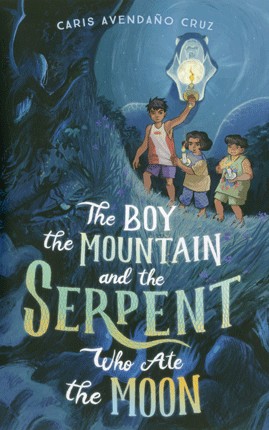| Boy, the mountain, and the serpent who ate the moon Author: Cruz, Caris Avendano | ||
| Price: $22.58 | ||
Summary:
Three Filipino children, Bayani, Isay, and Aaron, venture into a mystical land of monsters and gods from Filipino lore, where they must navigate dangers and find their way back home.
| Accelerated Reader Information: Interest Level: MG Reading Level: 4.70 Points: 9.0 Quiz: 554667 |
Reviews:
Kirkus Reviews (04/15/25)
School Library Journal (06/20/25)
Booklist (00/06/25)
Full Text Reviews:
Other - 04/28/2025 Over the past few years, the fictional town of Santo Cristo has become known as a place from which dozens of people have gone missing. During Santo Cristo’s annual fiesta and evening procession, three local kids-12-year-old Bayani, his younger sister Isay, and their cousin Aaron-become the latest in the string of disappearances when, as the trio cross a bridge, the structure inexplicably grows legs and runs away with the tweens as its unwilling passengers. It carries them to an eerie location seemingly removed from reality, where they encounter a kapre. The creature, of Filipino folklore, informs the children that they must again find and cross the bridge to return home. As the group embarks on their quest, they learn more about the mysterious place’s origins. Cruz (Markit and the Ocean of Stars) draws upon Filipino mythology to deliver a fantastical tale about overcoming fear and cultivating a love for the earth and its inhabitants. Bayani’s emboldening mantra-"There is always a way"-highlights the novel’s emphasis on positivity and tenacity as a means to counter literal and figurative darkness. It’s an engaging tale that blends magical adventure with hopeful depictions of friendship. Tagalog words and phrases appear throughout. Ages 8-12. Agent: Melanie Figueroa, Root Literary. (July) - Copyright 2025
School Library Journal - 06/20/2025 Gr 3–6—Twelve-year-old Bayani, described with brown skin and black eyes like most of the people in his village in the Philippines, wants to go to the prusisyon procession that takes place once a year. His mother worries that he will become one of The Lost, the many members of Santo Cristo who have disappeared. He cajoles his mother into letting him go with his spoiled little sister, Isay. When the siblings and their hesitant cousin Aaron cross a magical bridge, however, they might have sealed their fate. Can they survive monsters, move mountains to free the land from the everlasting night, and make The Lost found again? Cruz crafts a lush landscape through smells, textures, and colors that is an apt background for this story based on traditional myths. For those not familiar with these tales, it takes a bit to catch on, but the roles of each creature are explained by the end. While some personality changes of the initially self-absorbed characters are abrupt and the quick coming together of all communities a convenient plot device, the three main characters have a slow awakening of how their actions impact the world. There is no glossary for those unfamiliar with Tagalog that is sprinkled throughout the text, nor is there an author's note or some other grounding content for readers. However, that lack of translations for some of the terms in the story adds a sense of place and will not deter most readers. VERDICT A vivid world forms a backdrop to traditional Filipino tales and a positive realization of working for the greater good instead of self.—Clare A. Dombrowski - Copyright 2025 Publishers Weekly, Library Journal and/or School Library Journal used with permission.



